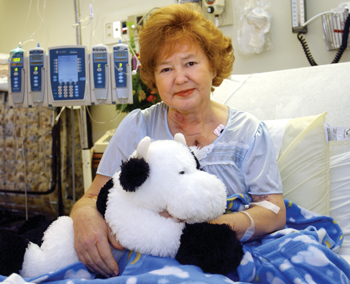
Betty Burroughs was the first patient in Tennessee to undergo a new minimally invasive heart valve replacement surgery available at VUMC.
photo by Dana Johnson
Less-invasive procedure eases valve replacement
In 1998 Betty Burroughs underwent open-heart surgery for a quintuple bypass. Soon after her recovery, doctors told her that she would eventually need aortic valve replacement.
Her physicians kept a close eye on the 61-year-old Gallatin resident because without the valve replacement her symptoms of aorotic stenosis would worsen. She was not too keen on the idea of having another open-heart surgery on the heels of her bypass.
It wasn't until this past summer that her condition raised more concern and the need for the replacement was grave.
“I began having breathing problems and chest pains when I exerted myself,” said Burroughs, a mail carrier for the city of Westmoreland. “I knew that it was time for the heart surgery but I just didn't want another open-heart procedure. But when I had the catheter done, my doctors told me about a new procedure that definitely interested me.”
Burroughs was the first patient at Vanderbilt University Medical Center to undergo a minimally invasive reoperative valve replacement surgery that required a small incision rather than cracking open her sternum.
The procedure was performed by John Byrne, M.D., chair of the Department of Cardiac Surgery at VUMC. This is the first procedure of its kind in Tennessee, Byrne said.
“Valve replacement is typically a high-risk surgery,” Byrne said. “But with this new procedure we can avoid injury to the rest of the cardiac structures, while lowering the likelihood of bleeding, need for transfusions and major complications.
“This procedure shows that we are able to redo valve surgery through small incisions with decreased mortality. High-risk surgeries are now lower risk because of advances in minimally invasive techniques.”
Byrne came to Vanderbilt in August from Brigham and Women's Hospital in Boston, where they performed 1,000 such surgeries. It is there that he and colleagues developed the minimally invasive procedures. Byrne expects the number of cases to increase at Vanderbilt with both aortic and mitral valve replacements.
Byrne likens the surgery to working on a ship in a bottle.
“If there was a need to change out one of the lifeboats on the ship, you would make a small incision and change out the lifeboat. It's just like what we do here. We go in and make a small incision in the upper sternum, go in and take out the valve and put in a new one.”
Byrne has written about the procedure in various medical journals and recently presented his findings at an American Heart Association scientific session.
As for Burroughs, she could not be happier with the outcome of her surgery. Since undergoing the procedure, her blood pressure has improved and she has been able to feel her heart beat instead of hearing the “honking” sound her heart made because of the bad valve.
“My scar is about half the size of my first one for bypass and I did not have my chest opened,” she said. “I knew I would have to have the surgery, period. But this option made it so much better. I would definitely recommend this to folks asking about it.”













